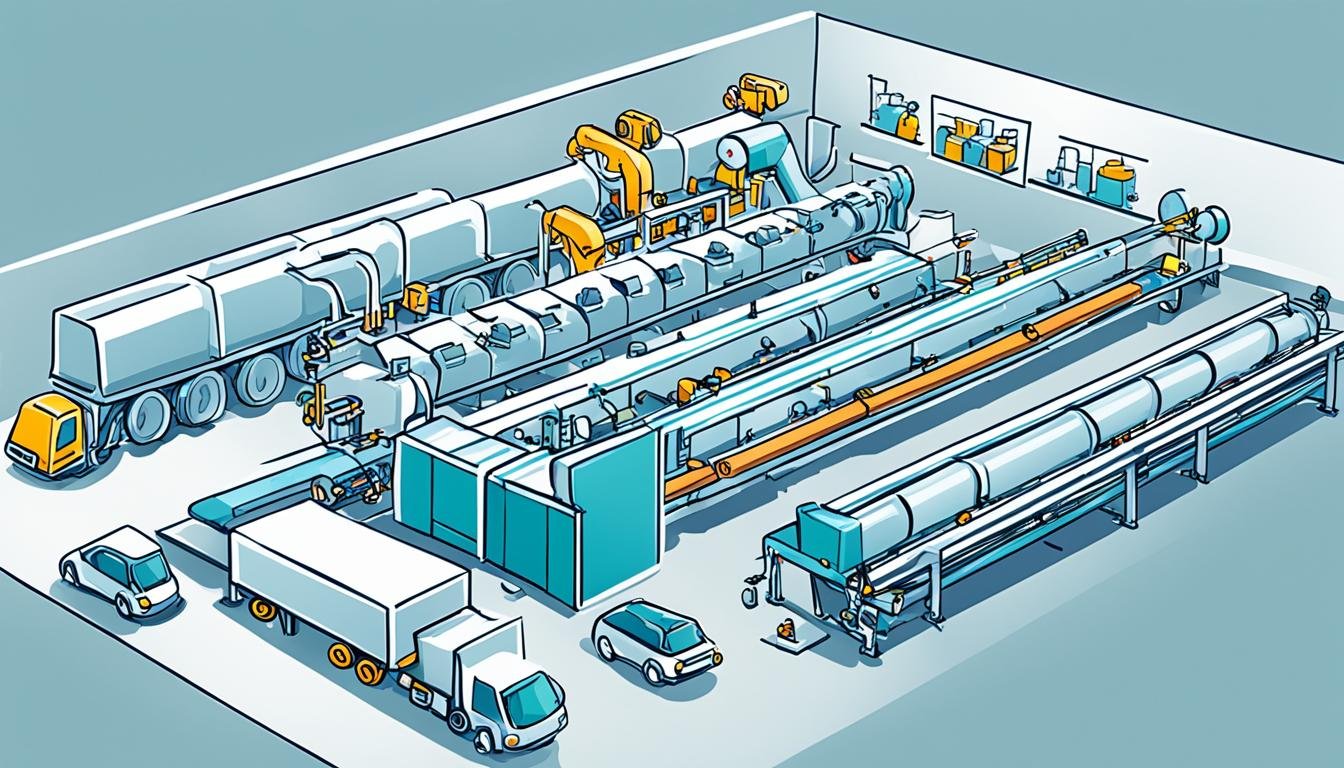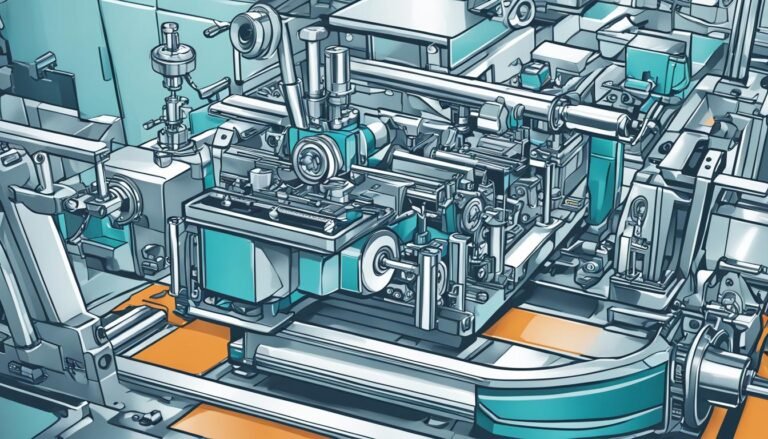Introduction to Lean Manufacturing Principles
Did you know that companies using lean manufacturing can cut production costs by about 25%? This approach started with Toyota over 50 years ago. It’s all about doing more with less and making sure customers get value. Now, it’s used in many fields, like cars, healthcare, and government, focusing on being efficient and always getting better.
Lean manufacturing is all about making things as needed, not in big batches. It values people and uses the 5S method to keep work areas safe and efficient. By getting rid of steps that don’t add value, lean manufacturing makes processes quick and quality products affordable.
Key Takeaways
- Lean manufacturing helps companies save a lot on production costs.
- At its core, lean thinking focuses on five key ideas: value, stream, flow, pull, and perfection.
- The 5S method helps make workspaces organized and efficient.
- Lean encourages smaller batches and just-in-time production.
- Using lean can make processes faster and boost productivity across different industries.
What is Lean Manufacturing?
Lean manufacturing aims to make things more efficient by focusing on what adds value for the customer and cutting out waste. It’s all about making products better and cheaper by getting rid of waste. Let’s explore what lean manufacturing is, where it came from, and what it aims to achieve.
Definition of Lean Manufacturing
Lean manufacturing is about getting rid of activities that don’t add value in the production process. It means making things simpler, cutting out extra steps, and using resources better. This approach helps make products better, cheaper, and faster by focusing on eliminating waste.
Origins and Historical Context
The roots of lean manufacturing go back to Toyota Motor Corporation. Shigeo Shingo and Taiichi Ohno developed the Toyota production system (TPS), which is the base of lean manufacturing. TPS was influenced by thinkers like Benjamin Franklin and Frederick Winslow Taylor, who talked about reducing waste and improving processes.
In the 1980s, John Krafcik used the term lean manufacturing, making it popular in many industries. This led to more companies adopting and improving these methods.
Core Goals of Lean Manufacturing
The main goals of lean manufacturing are to make customers happier, cut costs, and make things faster. It’s about always finding ways to make things better and more efficient. Companies like Toyota work hard to get rid of waste and make better products.
The lean approach is all about focusing on adding value and cutting waste in every part of the business.
The Five Core Principles of Lean
Lean Manufacturing is built on five key principles. These include identifying what customers value, mapping the production flow, ensuring smooth delivery, pulling production to meet demand, and always improving. Following these principles helps make the manufacturing process efficient and focused on adding value for customers.
Value
It’s important to know what customers value. This is done through interviews, surveys, and data analysis. By focusing on what customers need and want, Lean Manufacturing can start on the right path.
Value Stream Mapping
Mapping the value stream helps spot what adds value and what doesn’t in production. This method lets companies see their whole process. It helps find where things slow down and plan for better flow.
Flow
Improving the workflow means breaking tasks into smaller steps and making workloads even. Training workers to adapt helps too. The goal is to keep products moving smoothly, cutting down on delays and costs.
Pull System
A pull system cuts down on extra inventory by making products only when customers want them. This way, production matches customer needs more closely, reducing waste.
Perfection
Always aiming for perfection is key in Lean management. It encourages a culture of learning and growth. Through kaizen, or continuous improvement, companies work to make things better and waste less.
| Core Principle | Description | Benefits |
|---|---|---|
| Value | Defining value from the customer’s perspective | Increased customer satisfaction |
| Value Stream Mapping | Visualizing and analyzing the flow of materials and information | Identifying inefficiencies and opportunities for improvement |
| Flow | Creating a seamless production process | Reduced lead times and operational costs |
| Pull System | Producing based on actual demand | Minimized inventory waste |
| Perfection | Achieving continuous improvement | Enhanced process excellence and profitability |
Introduction to Lean Manufacturing Principles
Lean manufacturing is often seen as a way to cut costs or reduce jobs. But it’s really about making processes better and making customers happier. It focuses on sustainable practices that cut waste and keep quality high.
At its heart, lean manufacturing aims to give customers more value with less resources. By using methods like 5S and Kaizen, companies build a culture of constant improvement. Process efficiency comes from using techniques like predictive maintenance and visual systems to spot and remove waste.
Big names like Toyota, Honda, Boeing, and Dell have made lean manufacturing work for them. Their success shows how lean can improve quality control and make customers happy. These companies focus on reducing overproduction, excess inventory, and other waste.
Lean isn’t just for cars. Healthcare, government, food production, and construction have also used lean to get better. Making lean work often needs strong leadership and clear communication. Both Top-Down and Bottom-Up methods can work, depending on the company’s culture.
Lean makes sure production flows smoothly based on what customers want. The five main lean principles are about adding value, mapping the value stream, creating flow, pulling production, and aiming for perfection. These principles guide a structured path to lean success. Tools like TPM, Six Sigma, and 5S are key to making operations efficient and sustainable.
In summary, lean manufacturing is more than just tools and methods. It’s a philosophy that values customer satisfaction, environmental care, and being agile. It takes commitment from everyone in the company. It’s about constant improvement, valuing everyone’s input, and making sure processes meet customer needs.
The Role of the Toyota Production System (TPS)
The Toyota Production System (TPS) is a key part of Lean Manufacturing. It focuses on cutting waste and boosting efficiency. It started after World War II to fix Toyota’s manufacturing issues. TPS brought new ideas like Just-in-Time manufacturing and Jidoka to the production line.
Development of TPS
The Toyota Production System began with Sakichi and Kiichiro Toyoda’s ideas. They stressed “Daily Improvements” and “Good Thinking, Good Products.” Eiji Toyoda and Taiichi Ohno later built on these ideas, focusing on making things better.
Eiji Toyoda was key in adding Jidoka and Just-in-Time to TPS. This helped Toyota become a global leader in quality and productivity.
TPS also brought in the 5S system for organizing workspaces. This includes steps like Sort, Set in Order, Shine, Standardize, and Sustain. It made Toyota’s operations smoother and set standards for others to follow.
Key Concepts of TPS
Just-in-Time (JIT) and Jidoka are at the heart of TPS. JIT means making only what’s needed, when it’s needed, to cut waste and speed up production. Jidoka focuses on catching and stopping problems early to ensure quality.
Continuous improvement, or Kaizen, is also key. It drives Toyota to always get better. Akio Toyoda, Toyota’s Chairman, supports these ideas. He encourages the growth of TPS leaders who focus on constant improvement.
Source Links
- Lean 101: An Introduction to Lean Manufacturing
- Lean Manufacturing Overview 101
- An Introduction to Lean Manufacturing: Definition, Framework, and More
- What is Lean Manufacturing and the 5 Principles Used?
- Principles of Lean Manufacturing To Simplify and Scale | Rever
- Five Principles of Lean Management
- The Five Principles of Lean
- 5 Lean Principles Every Engineer Should Know
- Introduction to Lean Manufacturing
- Introduction to Lean Principles, Practices & Terminology | BradyID.com
- Toyota Production System | Vision & Philosophy | Company | Toyota Motor Corporation Official Global Website
- What is Toyota Lean Management?







